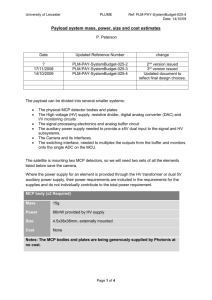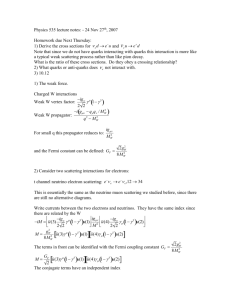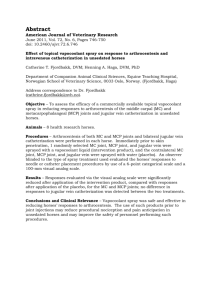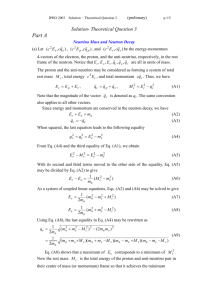Supplementary information (docx 1888K)
advertisement
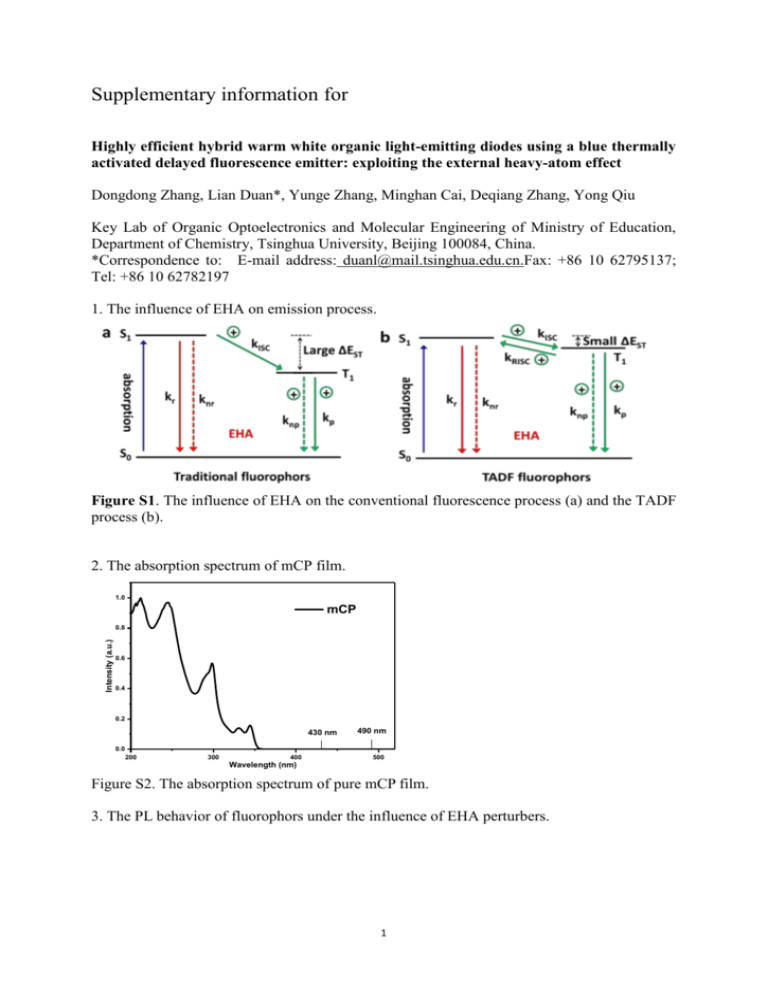
Supplementary information for Highly efficient hybrid warm white organic light-emitting diodes using a blue thermally activated delayed fluorescence emitter: exploiting the external heavy-atom effect Dongdong Zhang, Lian Duan*, Yunge Zhang, Minghan Cai, Deqiang Zhang, Yong Qiu Key Lab of Organic Optoelectronics and Molecular Engineering of Ministry of Education, Department of Chemistry, Tsinghua University, Beijing 100084, China. *Correspondence to: E-mail address: duanl@mail.tsinghua.edu.cn.Fax: +86 10 62795137; Tel: +86 10 62782197 1. The influence of EHA on emission process. Figure S1. The influence of EHA on the conventional fluorescence process (a) and the TADF process (b). 2. The absorption spectrum of mCP film. 1.0 mCP Intensity (a.u.) 0.8 0.6 0.4 0.2 430 nm 490 nm 0.0 200 300 400 500 Wavelength (nm) Figure S2. The absorption spectrum of pure mCP film. 3. The PL behavior of fluorophors under the influence of EHA perturbers. 1 0.45 2.5 a 0.40 0.45 mCP: Alq3: Ir(ppz)3 mCP: Alq3: Pt(COD)Cl2 1.5 mCP: Alq3: Pt(COD)Cl2 0.35 0.30 0.30 1.0 0.15 0.5 0.10 1.0 0.25 F0/F-1 0.20 PL efficiency 1.5 0.25 F0/F-1 PL efficiency b 0.40 2.0 mCP: Alq3: Ir(ppz)3 0.35 0.20 0.15 0.5 0.10 0.05 0.05 0.0 0.0 0.00 10 5 0 0.00 30 25 20 15 0 5 Concentration of phosphors (wt%) 10 15 20 25 30 Concentration of phosphors (wt%) Figure S3. a) The PL efficiency and the Stern-Volmer plot for mCP: 5% Alq3: Ir(ppz)3. b) The PL efficiency and the Stern-Volmer plot for mCP: 5% Alq3: Pt(COD)Cl2. 1.0 a 0 5 10 15 20 25 30 mCP: 5 wt% t-Bu4CzTPN-Firpic 0.8 0 5 10 15 20 25 30 0.6 Intensity (a.u.) Intensity (a.u.) 0.9 b mCP: 5 wt% t-Bu4CzTPN: Pt (COD)Cl2 0.6 0.4 0.3 0.2 500 550 600 650 700 550 750 600 650 700 750 Wavelength (nm) Wavelength (nm) 1.0 c 0.8 Intensity (a.u.) d 0 5 10 15 20 25 30 mCP: 5 wt% Bebq2: Pt(COD)Cl2 0.6 0 5 10 15 20 25 30 mCP: 5 wt% Bebq2: Ir(ppz)3 0.8 Intensity (a.u.) 1.0 0.4 0.6 0.4 0.2 0.2 0.0 500 550 600 650 700 450 750 500 1.0 1.0 e 0 5 10 15 20 25 30 mCP: 5 wt% Alq3: Ir(ppz)3 0.6 600 f 650 700 0 5 10 15 20 25 30 mCP: 5% Alq3: Pt(COD)Cl2 0.8 Intensity (a.u.) Intensity (a.u.) 0.8 550 Wavelength (nm) Wavelength (nm) 0.4 0.6 0.4 0.2 0.2 0.0 0.0 500 550 600 650 700 500 750 Wavelength (nm) 550 600 650 700 750 Wavelength (nm) Figure S4. a) The spectra of the films of mCP: 5% t-Bu4CzTPN: Pt(COD)Cl2. b) The spectra of the films of mCP: 5% t-Bu4CzTPN: Firpic. c) The spectra of the films of mCP: 5% Bebq2: 2 Pt(COD)Cl2. d) The spectra of the films of mCP: 5% Bebq2: Ir(ppz)3. e) The spectra of the films of mCP: 5% Alq3: Ir(ppz)3. f) The spectra of the films of mCP: 5% Alq3: Pt(COD)Cl2. 4. The PL transient decay curves of the fluorophors. 10000 0 5 10 15 20 25 mCP: t-Bu4CzTPN: Pt(COD)Cl2 Counts 1000 100 b 1000 Counts a 100 10 10 1 1 2500 5000 7500 10000 12500 20 15000 40 60 0 5 10 15 20 25 30 mCP: Alq3: Ir(ppz)3 100 100 10 0 5 10 15 20 25 30 mCP: Alq3: Pt(COD)Cl2 d 1000 Counts c 1000 80 Time (ns) Time (ns) Counts 0 5 10 15 20 25 mCP: Bebq2: Pt(COD)Cl2 100 10 1 1 50 100 150 200 250 100 150 200 Time (ns) 250 300 350 Time (ns) 3.00E+008 e kISC+knr kr 2.00E+008 kr Bebq2 -1 -1 Rate constant (s ) f kISC+knr Rate constant(s ) 2.50E+008 1.50E+008 1.00E+008 Alq3 5.00E+007 5.00E+007 0 5 10 15 20 0 Concentration of perturbers (wt%) 5 10 15 20 Concentration of perturbers (wt%) 80000000 70000000 g -1 Rate constant (s ) 60000000 50000000 40000000 kISC+knr 30000000 kr 20000000 t-Bu4CzTPN 10000000 0 5 10 15 20 Concentration of perturbers (wt%) Figure S5. a) The transient decay curves of films of mCP: t-Bu4CzTPN: Pt(COD)Cl2 observed at 570 nm with excitation wavelength of 430 nm. b) The transient decay curves of films of mCP: Bebq2: Pt(COD)Cl2 observed at 490 nm with excitation wavelength of 430 nm. 3 c) The transient decay curves of films of mCP: Alq3: Ir(ppz)3 observed at 520 nm with excitation wavelength of 430 nm. d) The transient decay curves of films of mCP: Alq3: Pt(COD)Cl2 observed at 520 nm with excitation wavelength of 430 nm. e) The rate constant of Bebq2 under the influence of Ir(ppz)3. f) The rate constant of Alq3 under the influence of Ir(ppz)3. g) The rate constant of t-Bu4CzTPN under the influence of Firpic. 1000 Counts 100 10 100 200 Time (ns) 300 400 Figure S6. The transient decay curves of t-Bu4CzTPN: Firpic in dichloromethane solution without degassing. The concentration of Firpic is gradually increased. The excitation wavelength is 490 nm while the observed wavelength is 570 nm. Table S1: Transient characteristics of the films. Films τ (ns) kS1 (s-1) Increase of kISC 8 mCP: Bebq2: 0% Ir(ppz)3 5.8 1.72×10 mCP: Bebq2: 5% Ir(ppz)3 4.5 2.22×108 0.5×108 mCP: Bebq2: 10% Ir(ppz)3 4.1 2.44×108 0.72×108 8 mCP: Bebq2: 15% Ir(ppz)3 3.5 2.86×10 1.14×108 mCP: Bebq2: 20% Ir(ppz)3 3.0 3.33×108 1.61×108 7 mCP: Alq3: 0% Ir(ppz)3 24.0 4.17×10 mCP: Alq3: 5% Ir(ppz)3 21.0 4.76×107 0.59×107 mCP: Alq3: 10% Ir(ppz)3 18.5 5.41×107 1.24×107 7 mCP: Alq3: 15% Ir(ppz)3 16.5 6.06×10 1.89×107 mCP: Alq3: 20% Ir(ppz)3 14.2 7.04×107 2.87×107 7 mCP: t-Bu4CzTPN: Firpic 17.0 5.88×10 t-Bu4CzTPN: Firpic in dichloromethane 10.0 1.00×108 Note: 1) The lifetime of mCP: t-Bu4CzTPN: Pt(COD)Cl2 are the lifetime of the prompt part of the decay curves. 2) The kS1 here stands for the rate of all the process of the singlet excitons. 3) The increase of kISC is the D-value of kS1 with or without EHA perturbers. 4) The fitting equation for the life-times of the PL decay curves of films is like below: Fit A B1 e( t /1 ) B2 e( t / 2 ) B3 e ( t / 3 ) . Where τ1 is the life-time of the prompt part of the photo decay curve, τ2 and τ3 is the life-time of the delayed part of the photo decay curve. 5. The PL characteristics of mCP: 2CzPN: PO-01 films. 4 0.90 0.90 a PL efficiency PL efficiency b 0.85 0.85 0.80 mCP: PO-01 0.75 0.80 0.75 0.70 0.70 0.65 0.65 0.2 0.4 0.6 0.8 mCP: 10% 2CzTPN: PO-01 0.0 1.0 0.2 0.4 0.6 0.8 1.0 Concentration of PO-01 (wt%) Concentration of PO-01 (wt%) 1200 1000 c mCP: 10% 2CzPN mCP: 10% 2CzPN: 0.4% PO-01 mCP: 0.4% PO-01 1200 800 1000 Intensity B d 1400 mCP: 10% 2CzPN mCP: 10% 2CzPN: 0.2% PO-01 mCP: 0.2% PO-01 600 800 600 400 400 200 200 0 0 450 500 550 600 650 700 750 800 450 500 1800 1600 1800 mCP: 10% 2CzPN mCP: 10% 2CzPN: 0.6% PO-01 mCP: 0.6% PO-01 e 1400 700 750 800 mCP: 10% 2CzPN mCP: 10% 2CzPN: 0.8% PO-01 mCP: 0.8% PO-01 Intensity 1200 1000 800 800 600 600 400 400 200 200 0 0 450 500 550 600 650 700 750 450 800 500 g 550 600 650 700 750 800 Wavelength (nm) Wavelength (nm) 1800 650 1400 1000 2000 600 f 1600 1200 Intensity 550 Wavelength (nm) A mCP: 10% 2CzPN mCP: 10% 2CzPN: 1 % PO-01 mCP: 1% PO-01 0.90 1600 h 0.85 PL efficiency Intensity 1400 1200 1000 800 600 0.80 0.75 calculated 0.70 400 200 0.65 0 450 500 550 600 650 700 750 800 0.2 0.4 0.6 0.8 1.0 Concentration of PO-01 (wt%) Wavelength (nm) Figure S7. a) The PL efficiencies of mCP: PO-01 films. b) The PL efficiencies of mCP: 2CzPN: PO-01 films. c) The PL spectrum of mCP: 5% 2CzPN: 0.2% PO-01 film and the separated spectra of 2CzPN and PO-01. d) The PL spectrum of mCP: 5% 2CzPN: 0.4% PO-01 film and the separated spectra of 2CzPN and PO-01. e) The PL spectrum of mCP: 5% 2CzPN: 0.6% PO-01 film and the separated spectra of 2CzPN and PO-01. f) The PL spectrum 5 of mCP: 5% 2CzPN: 0.8% PO-01 film and the separated spectra of 2CzPN and PO-01. g) The PL spectrum of mCP: 5% 2CzPN: 1.0% PO-01 film and the separated spectra of 2CzPN and PO-01. h) The calculated PL efficiencies of mCP: 2CzPN: PO-01 films. . 6. The PL characteristics of mCP: Bebq2: PO-01 films. 250000 mCP: 10% Bebq2: 0.2% PO-01 a 200000 mCP: 0.2% PO-01 mCP: 10% Bebq2: 0.4% PO-01 b mCP: 10% Bebq2 200000 mCP: 10% Bebq2 mCP: 0.4% PO-01 150000 Intensity Intensity 150000 100000 100000 50000 50000 0 0 400 450 500 550 600 650 700 750 400 Wavelength (nm) 500 550 600 650 700 750 800 Wavelength (nm) 300000 300000 mCP: 10% Bebq2: 0.8% PO-01 mCP: 10% Bebq2: 0.6% PO-01 c 250000 mCP: 10% Bebq2 mCP: 10% Bebq2 d 250000 mCP: 0.6% PO-01 mCP: 0.8% PO-01 200000 Intensity 200000 Intensity 450 150000 150000 100000 100000 50000 50000 0 0 400 500 600 700 400 800 500 600 700 800 Wavelength (nm) Wavelength (nm) 300000 mCP: 10% Bebq2: 1.0% PO-01 e 250000 0.9 mCP: 10% Bebq2 f mCP: 1.0% PO-01 0.8 PL efficiency Intensity 200000 150000 100000 0.7 0.6 mCP: PO-01 mCP: Bebq2: PO-01 measured mCP: Bebq2: PO-01 calculated 0.5 50000 0.4 0 400 450 500 550 600 650 700 750 800 0.0 0.2 Wavelength (nm) 0.4 0.6 0.8 1.0 Concentration of PO-01 Figure S8. a) The PL spectrum of mCP: 5% Bebq2: 0.2% PO-01 film and the separated spectra of 2CzPN and PO-01. b) The PL spectrum of mCP: 5% Bebq2: 0.4% PO-01 film and the separated spectra of 2CzPN and PO-01. c) The PL spectrum of mCP: 5% Bebq2: 0.6% PO-01 film and the separated spectra of 2CzPN and PO-01. d) The PL spectrum of mCP: 5% Bebq2: 0.8% PO-01 film and the separated spectra of 2CzPN and PO-01. e) The PL spectrum of mCP: 5% Bebq2: 1.0% PO-01 film and the separated spectra of 2CzPN and PO-01. f) The PL efficiencies of films. Table S2. The PL efficiencies of films. Ratio Films 2CzPN of Ratio PO-01 of calculated experimental mCP: 5%2CzPN: 0.2% PO-01 0.364 0.636 0.730 0.764 mCP: 5%2CzPN: 0.4% PO-01 0.295 0.705 0.775 0.803 6 mCP: 5%2CzPN: 0.6% PO-01 0.165 0.835 0.827 0.842 mCP: 5%2CzPN: 0.8% PO-01 0.144 0.856 0.850 0.854 mCP: 5%2CzPN: 1.0% PO-01 0.098 0.902 0.881 0.89 mCP: 0.2% PO-01 1.0 0.77 mCP: 0.4% PO-01 1.0 0.816 mCP: 0.6% PO-01 1.0 0.86 mCP: 0.8% PO-01 1.0 0.882 mCP: 1.0% PO-01 1.0 0.904 mCP: 5% 2CzPN 1.0 Note: the ratio of 2CzPN or PO-01 is the ratio of the photon. 0.66 Table S3. The energies of the compounds. singlet (eV) Triplet (eV) Alq3 2.4 2.0 Bebq2 2.52 2.26 t-Bu4CzTPN 2.24 2.17 2CzPN 2.6 2.5 HOMO (eV) 5.6 5.5 5.8 LUMO (eV) 2.8 2.8 3.0 Pt(COD)Cl2 - >3.0 - - Ir(ppz)3 - 3.0 5.0 1.6 Firpic - 2.62 5.9 2.85 PO-01 - 2.2 5.1 2.7 7. The performances of the WOLEDs. b a 100 2 Brightness (cd/m ) 2 Current density (A/m ) 1000 100 A: 6% 2CzPN: 0.2% PO-01 B: 10% 2CzPN: 0.2% PO-01 C: 20% 2CzPN: 0.2% PO-01 10 10 A: 6% 2CzPN: 0.2% PO-01 B: 10% 2CzPN: 0.2% PO-01 C: 20% 2CzPN: 0.2% PO-01 1 0.1 1 4 5 6 7 8 9 4 10 Voltage (V) 5 6 7 Voltage (V) 7 8 9 10 c Intensity (a.u.) 0.8 0.6 4V 5V 6V 7V 8V 9V 10 V 10% 2CzPN d 1.0 4V 5V 6V 7V 8V 9V 10 V 6% 2CzPN 0.8 Intensity (a.u.) 1.0 0.4 0.6 0.4 0.2 0.2 0.0 0.0 400 500 600 400 700 Wavelength (nm) 500 600 700 Wavelength (nm) 1.0 4V 5V 6V 7V 8V 9V 10 V 20% 2CzPN Intensity (a.u.) 0.8 0.6 4V 5V 6V 7V 8V 9V 10 V A: 6% 2CzPN f 0.8 0.6 CIE y e 1.0 0.4 0.4 0.2 0.2 0.0 0.0 400 500 600 700 Wavelength (nm) 1.0 CIE y 0.6 0.4 0.8 CIE y 0.8 0.2 0.4 CIE x 1.0 4V 5V 6V 7V 8V 9V 10 V B: 10% 2CzPN g 0.0 0.2 0.6 0.8 1.0 4V 5V 6V 7V 8V 9V 10 V C: 20% 2CzPN h 0.6 0.4 0.2 0.0 0.0 0.2 0.4 CIE x 0.6 0.8 0.0 0.0 1.0 0.3 CIE x 0.6 0.9 Figure S9. a) Brightness-voltage characteristics and b) current density-voltage characteristics of the WOLEDs. c) The spectra of device A. d) The spectra of device B. e) The spectra of device C. f) The CIE coordinates spectra of device A. g) The CIE coordinates spectra of device B. h) The CIE coordinates spectra of device C. 8. The performance of monochromatic devices mCP: 20% 2CzPN: 0.2% PO-01 mCP: 20% 2CzPN mCP: 0.2% PO-01 EQE 20 10 0 0 2000 4000 6000 8000 2 Brightness (cd/m ) 8 Figure S10. The performance of monochromatic devices of 2CzPN or PO-01 in the same device architecture. ITO/ HATCN (5 nm)/ NPB (40 nm)/ TCTA (10 nm)/ mCP: 20% 2CzPN or mCP: 0.2% PO-01(11 nm) / TAZ (40 nm)/ LiF (0.5 nm) /Al (150 nm). 9. The performance of WOLEDs with 26DCzPPy as the host. b Power efficiency (lm/W) Current Efficiency (cd/A) a 10 26DCzPPy: 20% 2CzPN: 0.2% PO-01 1 10 1 10 100 1.0 2 Brightness (cd/m ) 1000 0 1000 2000 3000 2 4000 5000 6000 Brightness (cd/m ) 4V 5V 6V 7V 8V c 0.8 Intensity (a.u.) 26DCzPPy: 20% 2CzPN: 0.2% PO-01 0.6 0.4 0.2 0.0 400 500 600 700 Wavelength (nm) Figure S11. a) The Current efficiency-brightness characteristics of the WOLED. b) The power efficiency-brightness characteristics of the WOLED. c) The spectra of the WOLED with increasing voltage. The device structure is ITO/ HATCN (5 nm)/ NPB (40 nm)/ TCTA (10 nm)/ 26DCzPPy: 20% 2CzPN: 0.2% PO-01(11 nm) / TAZ (40 nm)/ LiF (0.5 nm) /Al (150 nm). 10. The lifetime of devices. 110 100 a 100 b mCP: 20% 2CzPN: 0.5% PO-01 mCP: 20% 2CzPN mCP: 0.5% PO-01 90 80 80 B I/I0 (%) 60 70 26DCzPPy: 20% 2CzPN: 0.2% PO-01 mCP: 20% 2CzPN: 0.2% PO-01 40 60 20 50 40 0 20 40 60 80 100 120 0 140 Time (min) 0 100 200 Time (min) 300 400 500 Figure S12. a) The lifetimes of devices with mCP as the host. b) The lifetimes of WOLEDs with mCP or 26DCzPPy as the host. 9

